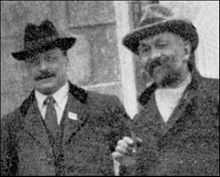Walter L. Cole
| Walter L. Cole | |
|---|---|
 | |
| Cole (right) with Arthur Griffith (left) | |
| Teachta Dála | |
| In office 9 September 1922 – 9 August 1923 | |
| Constituency | Cavan |
| Personal details | |
| Died | 26 April 1943 |
| Nationality | Irish |
| Political party | Sinn Féin (Pro-Treaty) Cumann na nGaedheal |
| Residence | Mountjoy Square, Dublin |
Walter Leonard Cole (died 26 April 1943) was an Irish merchant and politician in the early twentieth century. Prior to the foundation of the Irish Free State, he was an alderman for a period.[1] An active republican, he was a founding director of the Sinn Féin Printing & Publishing Company. He also led the Sinn Féin grouping in Dublin Corporation in the early 1900s.[2]
As a well-off supporter of the underground Irish republican movement in the early twentieth century, his house on Mountjoy Square seems to have been a regular meeting place for senior figures within that movement. The notes of Seamus Reader, an Irish Volunteer from Glasgow, record a meeting in January 1916 at Cole's house:
Shortly after 5pm on the 2nd, January 1916, I went to Cole's house, Mountjoy Square, Dublin, where, while waiting in the kitchen for tea, I jotted my coded notes for my report to Scotland. I then went to the room where I met Tom Clarke, Sean McDermott, J Connolly, P Pearse and McDonagh[3]
all of whom were signatories to the Proclamation of the Irish Republic and all of whom were executed the following May, as leaders of the Easter Rising.
Cole is also documented as having hosted provisional Dáil meetings at his home,[4][5] the assembly having been driven underground in September 1919. He was arrested by the military at his home at No. 3 Mountjoy Square in 1920.[1]
After the Anglo-Irish Treaty and the foundation of the Irish Free State, he was elected a pro-Treaty Sinn Féin Teachta Dála (TD) to the 3rd Dáil Éireann for Cavan constituency at the 1922 general election.[6] The "Pro-Treaty" prefix relates to his position in the Irish Civil War. It is perhaps surprising that a Dublin man won in Cavan. He and Seán Milroy stood alongside Arthur Griffith with one other opponent,[7] Patrick Baxter of the Farmers' Party and three seats available. Griffith received by far the largest popular vote (54%) with Baxter second (23%), Cole third (20%) and Milroy fourth (2%). As the Irish voting system uses proportional representation, Cole and Milroy were elected on the back of Griffith's surplus votes who had achieved more than twice the required quota.[8] Cole stood again in Cavan as a Cumann na nGaedheal candidate at the following 1923 general election. Griffith died during the Civil War by that time and Baxter topped the poll, this time with Milroy second. Cole was eliminated on the sixth count, despite there being an extra fourth seat.[9]
Cole unsuccessfully ran for election to Seanad Éireann in 1925.[10] He was later a commissioner for Mountjoy Square.[11]
References
- ↑ 1.0 1.1 "Civilians arrested By Military in Dublin" (FEE REQUIRED). The Irish Times. 18 September 1920. Retrieved 6 September 2008.
- ↑ Kelly, M. J. (2006). The Fenian Ideal and Irish Nationalism, 1882-1916. Boydell & Brewer Ltd. p. 149. ISBN 9781843832041.
- ↑ Reader, Seamus. "Volunteers from Scotland and the 1916 Rising, Interview with Sean MacDiarmada".
- ↑ Heagney, John (2006). "3". The Georgian Squares of Dublin. Four Courts Press.
- ↑ McCracken, J. L. (1958). Representative Government in Ireland: A Study of Dáil Éireann 1919-48. Oxford University Press. ASIN B0006D7GSU.
- ↑ "Mr. Walter L. Cole". Oireachtas Members Database. Retrieved 27 April 2009.
- ↑ Laffan, Michael (1999). "3". The Resurrection of Ireland: The Sinn Féin Party, 1916-1923. Cambridge University Press. p. 401. ISBN 9780521650731.
- ↑ "3rd Dail - Cavan First Preference Votes". ElectionsIreland.org. Retrieved 6 January 2009.
- ↑ "Walter L. Cole". ElectionsIreland.org. Retrieved 27 April 2009.
- ↑ "Mr. Walter Leonard Cole, 3 Mountjoy Square" (FEE REQUIRED). The Irish Times. 12 September 1925. Retrieved 6 September 2008.
- ↑ "Mountjoy Square for the Public" (FEE REQUIRED). The Irish Times. 8 March 1938. Retrieved 6 September 2008.